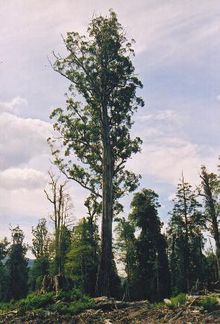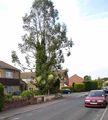Eucalyptus
| Eucalyptus | |
|---|---|
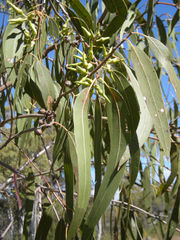 |
|
| Buds, capsules and foliage of E. terticornis | |
| Scientific classification | |
| Kingdom: | Plantae |
| (unranked): | Angiosperms |
| (unranked): | Eudicots |
| (unranked): | Rosids |
| Order: | Myrtales |
| Family: | Myrtaceae |
| Subfamily: | Myrtoideae |
| Tribe: | Eucalypteae |
| Genus: | Eucalyptus L'Hér. |
| Species | |
|
About 700; see the List of Eucalyptus species |
|
 |
|
| Natural range | |
| Synonyms | |
|
Aromadendron Andrews ex Steud. |
|
Eucalyptus (pronounced /ˌjuːkəˈlɪptəs/[2] ) is a diverse genus of flowering trees (and a few shrubs) in the myrtle family, Myrtaceae. Members of the genus dominate the tree flora of Australia. There are more than 700 species of Eucalyptus, mostly native to Australia, and a very small number are found in adjacent areas of New Guinea and Indonesia and one as far north as the Philippine archipelago and Taiwan. Only 15 species occur outside Australia, and only 9 do not occur in Australia. Species of Eucalyptus are cultivated throughout the tropics and subtropics including the Americas, Europe, Africa, the Mediterranean Basin, the Middle East, China and the Indian Subcontinent.
Eucalyptus is one of three similar genera that are commonly referred to as "eucalypts," the others being Corymbia and Angophora. Many, but far from all, are known as gum trees because many species exude copious sap from any break in the bark (e.g. Scribbly Gum). The generic name is derived from the Greek words ευ (eu), meaning "well," and καλυπτος (kalyptos), meaning well "covered," which refers to the operculum on the calyx that initially conceals the flower.[3]
Eucalyptus has attracted attention from global development researchers and environmentalists. It is a fast-growing source of wood, its oil can be used for cleaning and functions as a natural insecticide, and it is sometimes used to drain swamps and thereby reduce the risk of malaria. Outside their natural ranges, eucalypts are both lauded for their beneficial economic impact on poor populations[4][5]:22 and derided for being invasive water-suckers,[6] leading to controversy over their total impact.[7]
Contents |
Description
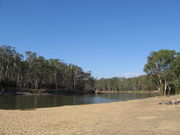
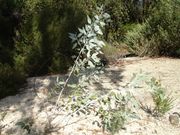
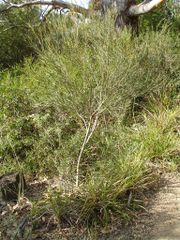
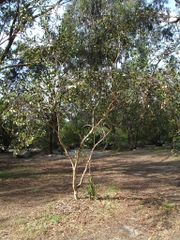
Size and habitat
A mature Eucalyptus may take the form of a low shrub or a very large tree. There are three main habit and four size categories that species can be divided into.
As a generalisation "forest trees" are single-stemmed and have a crown forming a minor proportion of the whole tree height. "Woodland trees" are single-stemmed although they may branch at a short distance above ground level.
"Mallees" are multi-stemmed from ground level, usually less than 10 m (33 ft) in height, often with the crown predominantly at the ends of the branchlets and individual plants may combine to form either an open or closed formation. Many mallee trees may be so low-growing as to be considered a shrub.
Two other tree forms are notable in Western Australia and described using the native names "mallet" and "marlock". The "mallet" is a small to medium-sized tree that does not produce lignotubers and has a relatively long trunk, a steeply branching habit and often a conspicuously dense terminal crown. This is the normal habit of mature healthy specimens of Eucalyptus occidentalis, E. astringens, E. spathulata, E. gardneri, E. dielsii, E. forrestiana, E. salubris, E. clivicola and E. ornata. The smooth bark of mallets often has a satiny sheen and may be white, cream, grey, green or copper.
The term marlock has been variously used; in Forest Trees of Australia it is defined as a small tree without lignotubers but with a shorter, lower-branching trunk than a mallet. They usually grow in more or less pure stands. Clearly recognisable examples are stands of E. platypus, E. vesiculosa and the unrelated E. stoatei.
The term "morrell" is somewhat obscure in origin and appears to apply to trees of the western Australian wheatbelt and goldfields which have a long, straight trunk, completely rough-barked. It is now used mainly for E. longicornis (Red Morrell) and E. melanoxylon (Black Morrell).
Tree sizes follow the convention of:
- Small — to 10 m (33 ft) in height
- Medium-sized — 10–30 m (33–98 ft)
- Tall — 30–60 m (98–200 ft)
- Very tall — over 60 m (200 ft)
Leaves
Nearly all Eucalyptus are evergreen but some tropical species lose their leaves at the end of the dry season. As in other members of the myrtle family, Eucalyptus leaves are covered with oil glands. The copious oils produced are an important feature of the genus. Although mature Eucalyptus trees are usually towering and fully leafed, their shade is characteristically patchy because the leaves usually hang downwards.
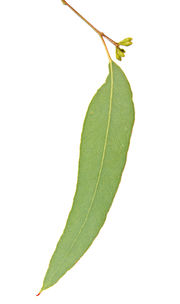
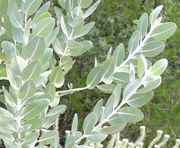
The leaves on a mature Eucalyptus plant are commonly lanceolate, petiolate, apparently alternate and waxy or glossy green. In contrast, the leaves of seedlings are often opposite, sessile and glaucous. But there are many exceptions to this pattern. Many species such as E. melanophloia and E. setosa retain the juvenile leaf form even when the plant is reproductively mature. Some species, such as E. macrocarpa, E. rhodantha and E. crucis, are sought-after ornamentals due to this lifelong juvenile leaf form. A few species, such as E. petraea, E. dundasii and E. lansdowneana, have shiny green leaves throughout their life cycle. E. caesia exhibits the opposite pattern of leaf development to most Eucalyptus, with shiny green leaves in the seedling stage and dull, glaucous leaves in mature crowns. The contrast between juvenile and adult leaf phases is valuable in field identification.
Four leaf phases are recognised in the development of a Eucalyptus plant: the ‘seedling’, ‘juvenile’, ‘intermediate’ and ‘adult’ phases. However there is no definite transitional point between the phases. The intermediate phase, when the largest leaves are often formed, links the juvenile and adult phases.[8]
In all except a few species, the leaves form in pairs on opposite sides of a square stem, consecutive pairs being at right angles to each other (decussate). In some narrow-leaved species, for example E. oleosa, the seedling leaves after the second leaf pair are often clustered in a detectable spiral arrangement about a five-sided stem. After the spiral phase, which may last from several to many nodes, the arrangement reverts to decussate by the absorption of some of the leaf-bearing faces of the stem. In those species with opposite adult foliage the leaf pairs, which have been formed opposite at the stem apex, become separated at their bases by unequal elongation of the stem to produce the apparently alternate adult leaves.
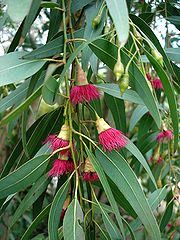
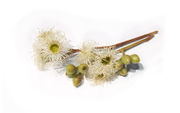
Flowers
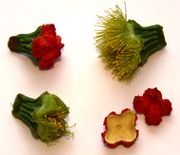
The most readily recognisable characteristics of Eucalyptus species are the distinctive flowers and fruit (capsules or "gumnuts"). Flowers have numerous fluffy stamens which may be white, cream, yellow, pink or red; in bud, the stamens are enclosed in a cap known as an operculum which is composed of the fused sepals or petals or both. Thus flowers have no petals, but instead decorate themselves with the many showy stamens. As the stamens expand, the operculum is forced off, splitting away from the cup-like base of the flower; this is one of the features that unites the genus. The name Eucalyptus, from the Greek words eu-, well, and kaluptos, cover, meaning "well-covered", describes the operculum. The woody fruits or capsules are roughly cone-shaped and have valves at the end which open to release the seeds. Most species do not flower until adult foliage starts to appear; Eucalyptus cinerea and Eucalyptus perriniana are notable exceptions.
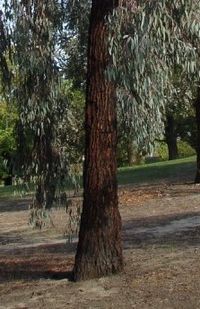
Bark
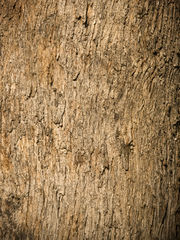
The appearance of Eucalyptus bark varies with the age of the plant, the manner of bark shed, the length of the bark fibres, the degree of furrowing, the thickness, the hardness and the colour. All mature eucalypts put on an annual layer of bark, which contributes to the increasing diameter of the stems. In some species, the outermost layer dies and is annually deciduous, either in long strips (as in Eucalyptus sheathiana) or in variably sized flakes (E. diversicolor, E. cosmophylla or E. cladocalyx). These are the gums or smooth-barked species. The gum bark may be dull, shiny or satiny (as in E. ornata) or matte (E. cosmophylla). In many species, the dead bark is retained. Its outermost layer gradually fragments with weathering and sheds without altering the essentially rough-barked nature of the trunks or stems — for example E. marginata, E. jacksonii, E. obliqua and E. porosa.
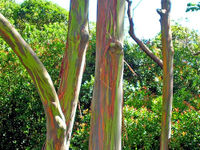
Many species are ‘half-barks’ or ‘blackbutts’ in which the dead bark is retained in the lower half of the trunks or stems — for example, E. brachycalyx, E. ochrophloia and E. occidentalis — or only in a thick, black accumulation at the base, as in E. clelandii. In some species in this category, for example E. youngiana and E. viminalis, the rough basal bark is very ribbony at the top, where it gives way to the smooth upper stems. The smooth upper bark of the half-barks and that of the completely smooth-barked trees and mallees can produce remarkable colour and interest, for example E. deglupta.[8]
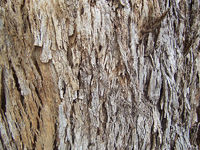
Bark characteristics
- Stringybark — consists of long fibres and can be pulled off in long pieces. It is usually thick with a spongy texture.
- Ironbark — is hard, rough and deeply furrowed. It is impregnated with dried kino (a sap exuded by the tree) which gives a dark red or even black colour.
- Tessellated — bark is broken up into many distinct flakes. They are corkish and can flake off.
- Box — has short fibres. Some also show tessellation.
- Ribbon — this has the bark coming off in long thin pieces but still loosely attached in some places. They can be long ribbons, firmer strips or twisted curls.
Species and hybridism
There are over 700 species of Eucalyptus; refer to the List of Eucalyptus species for a comprehensive list of species. Some have diverged from the mainstream of the genus to the extent that they are quite isolated genetically and are able to be recognised by only a few relatively invariant characteristics. Most, however, may be regarded as belonging to large or small groups of related species, which are often in geographical contact with each other and between which gene exchange still occurs. In these situations many species appear to grade into one another, and intermediate forms are common. In other words, some species are relatively fixed genetically, as expressed in their morphology, while others have not diverged completely from their nearest relatives.
Hybrid individuals have not always been recognised as such on first collection and some have been named as new species, such as E. chrysantha (E. preissiana × E. sepulcralis) and E. "rivalis" (E. marginata × E. megacarpa). Hybrid combinations are not particularly common in the field, but some other published species frequently seen in Australia have been suggested to be hybrid combinations. For example, E. erythrandra is believed to be E. angulosa × E. teraptera and due to its wide distribution is often referred to in texts.[8]
Related genera
A small genus of similar trees, Angophora, has also been known since the 18th century. In 1995 new evidence, largely genetic, indicated that some prominent Eucalyptus species were actually more closely related to Angophora than to the other eucalypts; they were split off into the new genus Corymbia. Although separate, the three groups are allied and it remains acceptable to refer to the members of all three genera, Angophora, Corymbia and Eucalyptus, as "eucalypts".
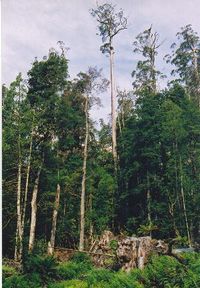
Tall timber
Several eucalypts are among the tallest trees in the world. Eucalyptus regnans, the Australian Mountain Ash, is the tallest of all flowering plants (Angiosperms); today, the tallest measured specimen named Centurion is 99.6 m (327 ft) tall.[9] Only Coast Redwood is taller and Coast Douglas-fir about the same; they are conifers (Gymnosperm). Six other eucalypt species exceed 80 metres in height: Eucalyptus obliqua, Eucalyptus delegatensis, Eucalyptus diversicolor, Eucalyptus nitens, Eucalyptus globulus and Eucalyptus viminalis.
Tolerance
Most eucalypts are not tolerant of frost, or only tolerate light frosts down to –3 °C to –5 °C; the hardiest are the so-called Snow Gums, such as Eucalyptus pauciflora which is capable of withstanding cold and frost down to about –20 °C. Two subspecies, E. pauciflora subsp. niphophila and E. pauciflora subsp. debeuzevillei in particular are even hardier and can tolerate even quite severe winters. Several other species, especially from the high plateau and mountains of central Tasmania such as Eucalyptus coccifera, Eucalyptus subcrenulata, and Eucalyptus gunnii, have produced extreme cold-hardy forms and it is seed procured from these genetically hardy strains that are planted for ornament in colder parts of the world.
Animal relationships
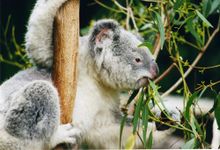
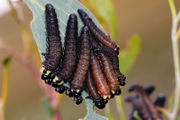
An essential oil extracted from Eucalyptus leaves contains compounds that are powerful natural disinfectants and can be toxic in large quantities. Several marsupial herbivores, notably koalas and some possums, are relatively tolerant of it. The close correlation of these oils with other more potent toxins called formylated phloroglucinol compounds allows koalas and other marsupial species to make food choices based on the smell of the leaves. For koalas, these compounds are the most important factor in leaf choice.
Eucalyptus flowers produce a great abundance of nectar, providing food for many pollinators including insects, birds, bats and possums. Although Eucalyptus trees are seemingly well-defended from herbivores by the oils and phenolic compounds, they have insect pests. These include the Eucalyptus Longhorn Borer Phoracantha semipunctata and the aphid-like psyllids known as "bell lerps", both of which have become established as pests throughout the world wherever eucalypts are cultivated.
Fire
On warm days vaporised Eucalyptus oil rises above the bush to create the characteristic distant blue haze of the Australian landscape. Eucalyptus oil is highly flammable (trees have been known to explode[7][10]) and bush fires can travel easily through the oil-rich air of the tree crowns. The dead bark and fallen branches are also flammable. Eucalypts are well adapted for periodic fires via lignotubers and epicormic shoots under the bark.
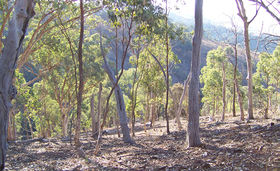

Eucalypts originated between 35 and 50 million years ago, not long after Australia-New Guinea separated from Gondwana, their rise coinciding with an increase in fossil charcoal deposits (suggesting that fire was a factor even then), but they remained a minor component of the Tertiary rainforest until about 20 million years ago, when the gradual drying of the continent and depletion of soil nutrients led to the development of a more open forest type, predominantly Casuarina and Acacia species. With the arrival of the first humans about 50 thousand years ago, fires became much more frequent and the fire-loving eucalypts soon came to account for roughly 70% of Australian forest.
The two valuable timber trees, Alpine Ash E. delegatensis and Australian Mountain Ash E. regnans, are killed by fire and only regenerate from seed. The same 2003 bushfire that had little impact on forests around Canberra resulted in thousands of hectares of dead ash forests. However, a small amount of ash survived and put out new ash trees as well. There has been some debate as to whether to leave the stands or attempt to harvest the mostly undamaged timber, which is increasingly recognised as a damaging practice.
Cultivation, uses, and environmental effects

Eucalypts have many uses which have made them economically important trees, and have become a cash crop in poor areas such as Timbuktu, Africa[5]:22 and the Peruvian Andes,[4] despite concerns that the trees are invasive in some countries like South Africa.[6] Best-known are perhaps the varieties Karri and Yellow box. Due to their fast growth, the foremost benefit of these trees is their wood. They can be chopped off at the root and grow back again. They provide many desirable characteristics for use as ornament, timber, firewood and pulpwood. Eucalyptus is considered the world’s top quality pulping species due to its high fibre yields. It is also used in a number of industries, from fence posts and charcoal to cellulose extraction for biofuels. Fast growth also makes eucalypts suitable as windbreaks and to reduce erosion.
Eucalypts draw a tremendous amount of water from the soil through the process of transpiration. They have been planted (or re-planted) in some places to lower the water table and reduce soil salination. Eucalypts have also been used as a way of reducing malaria by draining the soil in Algeria, Lebanon, Sicily,[11], elsewhere in Europe, and California.[12] Drainage removes swamps which provide a habitat for mosquito larvae, but can also destroy ecologically productive areas. This drainage is limited to the soil surface only, because the eucalyptus roots have up to 2.5 m (8.2 ft) length, not reaching the phreatic zone; thus rain or irrigation can wet the soil again.
Eucalyptus oil is readily steam distilled from the leaves and can be used for cleaning, deodorising, and in very small quantities in food supplements, especially sweets, cough drops and decongestants. It also has insect repellent properties (Jahn 1991 a, b; 1992), and is an active ingredient in some commercial mosquito repellents (Fradin & Day 2002).[13]
The nectar of some eucalypts produces high-quality monofloral honey. Eucalypt wood is also commonly used to make digeridoos, a traditional Australian Aboriginal wind instrument. The trunk of the tree is hollowed out by termites, and then cut down if the bore of is the correct size and shape.
All parts of Eucalyptus may be used to make dyes that are substantive on protein fibres such as (silk and wool), simply by processing the plant part with water. Colours to be achieved range from yellow and orange through green, tan, chocolate and deep rust red.[14] The material remaining after processing can be safely used as mulch or fertiliser.
Plantation and ecological problems
Eucalyptus was first introduced from Australia to the rest of the world by Sir Joseph Banks, botanist, on the Cook expedition in 1770. It was subsequently introduced to many parts of the world, notably California, Brazil, Ecuador, Colombia, Ethiopia, Morocco, Portugal, South Africa, Uganda, Israel, Galicia and Chile. In Portugal and also Spain, eucalypts have been planted in pulpwood plantations. Eucalyptus are the basis for several industries, such as sawmilling, pulp, charcoal and others. Several species have become invasive and are causing major problems for local ecosystems, mainly due to the absence of wildlife corridors and rotations management.
Due to similar favorable climatic conditions, Eucalyptus plantations have often replaced oak woodlands, for example in California and Portugal. The resulting monocultures have raised concerns about loss of biological diversity, through loss of acorns that mammals and birds feed on, absence of hollows that in oak trees provide shelter and nesting sites for birds and small mammals and for bee colonies, as well as lack of downed trees in managed plantations.
In seasonally dry climates oaks are often fire-resistant, particularly in open grasslands, as a grass fire is insufficient to ignite the scattered trees. In contrast a eucalyptus forest tends to promote fire because of the volatile and highly combustible oils produced by the leaves, as well as the production of large amounts of litter which is high in phenolics, preventing its breakdown by fungi and thus accumulates as large amounts of dry, combustible fuel.[15] Consequently, dense eucalypt plantings may be subject to catastrophic firestorms. Eucalypts obtain their long-term fire survivability from their ability to regenerate from epicormic shoots and lignotubers,[15] or by producing serotinous fruits.
North America
California. In the 1850s, Eucalyptus trees were introduced to California by Australians during the California Gold Rush. Much of California has a similar climate to parts of Australia. By the early 1900s, thousands of acres of eucalypts were planted with the encouragement of the state government. It was hoped that they would provide a renewable source of timber for construction, furniture making and railroad ties. It was soon found that for the latter purpose eucalyptus was particularly unsuitable, as the ties made from eucalyptus had a tendency to twist while drying, and the dried ties were so tough that it was nearly impossible to hammer rail spikes into them.
"They went on to note that the promise of eucalyptus in California was based on the old virgin forests of Australia. This was a mistake as the young trees being harvested in California could not compare in quality to the centuries-old eucalyptus timber of Australia. It reacted differently to harvest. The older trees didn't split or warp as the infant California crop did. There was a vast difference between the two, and this would doom the California eucalyptus industry."[16]
One way in which the eucalyptus, mainly the blue gum E. globulus, proved valuable in California was in providing windbreaks for highways, orange groves, and other farms in the mostly treeless central part of the state. They are also admired as shade and ornamental trees in many cities and gardens.
Eucalyptus forests in California have been criticised because they compete with native plants and do not support native animals. Fire is also a problem. The 1991 Oakland Hills firestorm which destroyed almost 3,000 homes and killed 25 people was partly fueled by large numbers of eucalypts close to the houses.[17]
In some parts of California, eucalypt forests are being removed and native trees and plants restored. Individuals have also illegally destroyed some trees and are suspected of introducing insect pests from Australia which attack the trees.[18]
Eucalyptus trees do exceptionally well in the Pacific Northwest: Washington, Oregon and parts of British Columbia.
South America
Uruguay. Antonio Lussich introduced Eucalyptus into Uruguay in approximately 1896, throughout what is now Maldonado Department, and it has spread all over the south-eastern and eastern coast. There had been no trees in the area because it consisted of dry sand dunes and stones. (Lussich also introduced many other trees, particularly Acacia and Pines, but they have not expanded so massively.)
Brazil. Eucalyptus was introduced to Brazil in 1910, for timber substitution and the charcoal industry. It has thrived in the local environment, and today there are around 5 million hectares planted. The wood is highly appreciated by the charcoal and pulp and paper industries. The short rotation allows a larger wood production and supplies wood for several other activities, helping to preserve the native forests from logging. When well managed, the plantations are sustainable and the soil can sustain endless replanting. Eucalyptus plantations are also used as wind breaks. Brazil's plantations have world-record rates of growth, typically over 40 cubic metres per hectare per year,[19] and commercial harvesting occurs after years 5. Due to the continual development and governmental funding, year-on-year growth is consistently being improved. Eucalyptus can produce up to 100 cubic metres per hectare per year. Brazil has become the top exporter and producer of Eucalyptus roundwood and pulp, and has played an important role in developing the Australian market through the country's committed research in this area. The local iron producers in Brazil rely heavily on sustainably grown Eucalyptus for charcoal; this has greatly pushed up the price of charcoal in recent years. The plantations are generally owned and operated for national and international industry by timber asset companies such as Thomson Forestry, Greenwood Management or cellulose producers such as Aracruz Cellulose and Stora Enso. In the 1990’s, Brazil exported approximately $1 billion, and by 2005, $3.5 billion. This trade surplus has drawn large amounts of foreign investments to the agricultural sector. The European Investment Bank and the World Bank have given full public support for foreign investment in Brazil’s pulp and paper industry and cellulose processing plants. Private industry in Brazil has invested $12 billion so far in pulp and paper since 1993 and has recently pledged to invest an extra $14 billion within the sector over the next decade. The forest products industry accounts for 3% of all global trade accounting for over $200 billion USD per year. The recent presence of many foreign TIMO's (Timberland Investment Management Organizations) is a reassurance of the economic potential of the forestry activity. Worldwide TIMO's manage assets worth more than $52 million, of which $8 billion is to be invested into Brazils developments before 2012.
Overall, South America is expected to produce 55% of the world's Eucalyptus round-wood by 2010.
Africa
Ethiopia. Eucalyptus was introduced to Ethiopia in either 1894 or 1895, either by Emperor Menelik II's French advisor Mondon-Vidailhet or by the Englishman Captain O'Brian. Menelik II endorsed its planting around his new capital city of Addis Ababa because of the massive deforestation around the city for firewood. According to Richard R.K. Pankhurst, "The great advantage of the eucalypts was that they were fast growing, required little attention and when cut down grew up again from the roots; it could be harvested every ten years. The tree proved successful from the onset".[20] Plantations of eucalypts spread from the capital to other growing urban centers such as Debre Marqos. Pankhurst reports that the most common species found in Addis Ababa in the mid-1960s was E. globulus, although he also found E. melliodora and E. rostrata in significant numbers. David Buxton, writing of central Ethiopia in the mid-1940s, observed that eucalyptus trees "have become an integral -- and a pleasing -- element in the Shoan landscape and has largely displaced the slow-growing native 'cedar' Juniperus procera)."[21]
It was commonly believed that the thirst of the Eucalyptus "tended to dry up rivers and wells", creating such opposition to the species that in 1913 a proclamation was issued ordering a partial destruction of all standing trees, and their replacement with mulberry trees. Pankhurst reports, "The proclamation however remained a dead letter; there is no evidence of eucalypts being uprooted, still less of mulberry trees being planted."[22] Eucalypts remain a defining feature of Addis Ababa.
Madagascar. Much of Madagascar's original native forest has been replaced with Eucalyptus, threatening biodiversity by isolating remaining natural areas such as Andasibe-Mantadia National Park.
South Africa. Numerous Eucalyptus species have been introduced into South Africa, mainly for timber and firewood but also for ornamental purposes. They are popular with beekeepers for the honey they provide.[23] However, in South Africa they are considered invasive, with their water-sucking capabilities threatening water supplies. They also release a chemical into the surrounding soil which kills native competitors.[6]
Eucalyptus seedlings are usually unable to compete with the indigenous grasses, but after a fire when the grass cover has been removed, a seed-bed may be created. The following Eucalyptus species have been able to become naturalised in South Africa: E. camaldulensis, E. cladocalyx, E. diversicolor, E. grandis and E. lehmannii.[23]
Zimbabwe. As in South Africa, many Eucalyptus species have been introduced into Zimbabwe, mainly for timber and firewood, and E. robusta and E. tereticornis have been recorded as having become naturalised there.[23]
Europe
In continental Portugal, the Azores and Galicia numerous oak forests have been replaced with eucalyptus, which are farmed for pulpwood, with severe effects on wildlife.
In Italy, the eucalyptus only arrived at the turn of the 19th Century and large scale plantations were started at the beginning of the 20th Century with the aim of drying up swampy ground to defeat malaria. This, their rapid growth in the Italian climate and excellent function as windbreaks has made them a common sight in the Center and South of the country, including the islands of Sardinia and Sicily. They are also valued for the characteristic smelling and tasting honey that is produced from them. The variety of eucalyptus most commonly found in Italy is Eucalyptus camaldulensis.[24]
History
Although eucalypts must have been seen by the very early European explorers and collectors, no botanical collections of them are known to have been made until 1770 when Joseph Banks and Daniel Solander arrived at Botany Bay with Captain James Cook. There they collected specimens of E. gummifera and later, near the Endeavour River in northern Queensland, E. platyphylla; neither of these species was named as such at the time.
In 1777, on Cook's third expedition, David Nelson collected a eucalypt on Bruny Island in southern Tasmania. This specimen was taken to the British Museum in London, and was named Eucalyptus obliqua by the French botanist L'Héritier, who was working in London at the time. He coined the generic name from the Greek roots eu and calyptos, meaning "well" and "covered" in reference to the operculum of the flower bud which protects the developing flower parts as the flower develops and is shed by the pressure of the emerging stamens at flowering. It was most likely an accident that L'Heritier chose a feature common to all eucalypts.
The name obliqua was derived from the Latin obliquus, meaning "oblique", which is the botanical term describing a leaf base where the two sides of the leaf blade are of unequal length and do not meet the petiole at the same place.
E. obliqua was published in 1788-89, which coincided with the first official European settlement of Australia. Between then and the turn of the 19th century, several more species of Eucalyptus were named and published. Most of these were by the English botanist James Edward Smith and most were, as might be expected, trees of the Sydney region. These include the economically valuable E. pilularis, E. saligna and E. tereticornis.
The first endemic Western Australian Eucalyptus to be collected and subsequently named was the Yate (E. cornuta) by the French botanist Jacques Labillardière, who collected in what is now the Esperance area in 1792.[8]
Several great Australian botanists were active during the 19th century, particularly Ferdinand von Mueller, whose work on eucalypts contributed greatly to the first comprehensive account of the genus in George Bentham's Flora Australiensis in 1867, which today remains the only complete Australian flora. The account is the most important early systematic treatment of the genus. Bentham divided it into five series whose distinctions were based on characteristics of the stamens, particularly the anthers (Mueller, 1879-84), work elaborated by Joseph Henry Maiden (1903-33) and still further by William Faris Blakely (1934). The anther system became too complex to be workable and more recent systematic work has concentrated on the characteristics of buds, fruits, leaves and bark.
See also
- Currency Creek Arboretum
- Eucalyptol
- Eucalyptus oil
- List of Eucalyptus species
Photo gallery
 Eucalyptus sideroxylon, showing fruit (capsules) & buds with operculum present. |
 Eucalyptus forest in East Gippsland, Victoria. Mostly Eucalyptus albens (white box). |
 Eucalyptus forest in East Gippsland, Victoria. Mostly Eucalyptus albens (white box). |
 Eucalyptus forest in East Gippsland, Victoria. Mostly Eucalyptus albens (white box). |
|
A Eucalyptus tree with the sun shining through its branches. |
Eucalyptus bridgesiana (Apple box) on Red Hill, Australian Capital Territory. |
 Eucalyptus cinerea x pulverulenta - National Botanical Gardens Canberra |
|
 Eucalyptus gall |
 Eucalyptus grandis. Province of Buenos Aires, Argentina. |
A Snow Gum (E. pauciflora), in winter in the Australian Alps |
|
 Eucalyptus rubida (Candlebark gum) in Burra, New South Wales. |
This tree in Heathcote National Park has a serious problem. |
Corymbia maculata trees South Coast New South Wales |
Eucalyptus chapmaniana (Bogong Gum) in Kew Gardens, London |
 Eucalyptus regnans trees in Sherbrooke Forest, Victoria |
Notes
- ↑ "Eucalyptus L'Hér.". Germplasm Resources Information Network. United States Department of Agriculture. 2009-01-27. http://www.ars-grin.gov/cgi-bin/npgs/html/genus.pl?4477. Retrieved 2010-02-28.
- ↑ Sunset Western Garden Book, 1995:606–607
- ↑ Gledhill, D. (2008). The Names of Plants (4 ed.). Cambridge University Press. p. 158. ISBN 9780521866453. http://books.google.com/books?id=NJ6PyhVuecwC.
- ↑ 4.0 4.1 Luzar J. (2007). The Political Ecology of a “Forest Transition”: Eucalyptus forestry in the Southern Peruvian. Ethnobotany Research & Applications.
- ↑ 5.0 5.1 WorldWatch Institute. (2007) State of the World: Our Urban Future.
- ↑ 6.0 6.1 6.2 VOA. (2005) South Africa Water Project Clears Water-Guzzling Alien Plant Infestations.
- ↑ 7.0 7.1 Santos, Robert L. (1997). "Section Three: Problems, Cares, Economics, and Species". The Eucalyptus of California. California State University. http://library.csustan.edu/bsantos/section3.htm.
- ↑ 8.0 8.1 8.2 8.3 Brooker & Kleinig (2001)
- ↑ "Tasmania's Ten Tallest Giants". Tasmanian Giant Trees Consultative Committee. http://www.gianttrees.com.au/tall.htm. Retrieved 2009-01-07.
- ↑ "Eucalytus Roulette (con't)". Robert Sward: Poet, Novelist and Workshop Leader. http://www.robertsward.com/eucmore.htm.
- ↑ Mrs. M. Grieve. "A Modern Herbal:Eucalyptus". http://www.botanical.com/botanical/mgmh/e/eucaly14.html. Retrieved 2005-01-27.
- ↑ Santos, Robert L (1997). "Section Two: Physical Properties and Uses". The Eucalyptus of California. California State University. http://wwwlibrary.csustan.edu/bsantos/section2.htm#FIGHTING.
- ↑ www.cdc.gov/od/oc/media/pressrel.r050428.htm
- ↑ India Flint, Botanical Alchemist. "The Scent of Eucalyptus." http://www.indiaflint.com/page6.htm
- ↑ 15.0 15.1 Reid, J.B. & Potts, B.M. (2005). Eucalypt Biology. In: Reid et al. (eds.) Vegetation of Tasmania., pp. 198-223. Australian Government.
- ↑ Santos, Robert L. (1997). "Seeds of Good or Seeds of Evil?". The Eucalyptus of California. California State University. http://www.library.csustan.edu/bsantos/euctoc.htm.
- ↑ Williams, Ted (January 2002). "America's Largest Weed". Audubon Magazine. http://magazine.audubon.org/incite/incite0201.html.
- ↑ Henter, Heather (January 2005). "Tree Wars: The Secret Life of Eucalyptus". Alumni. University of California, San Diego. http://alumni.ucsd.edu/magazine/vol2no1/features/wars.htm.
- ↑ "Brazil Eucalyptus Potential Productivity". Colorado State University. http://lamar.colostate.edu/~binkley/Brazileucalyptus.htm.
- ↑ Pankhurst p. 246
- ↑ David Buxton, Travels in Ethiopia, second edition (London: Benn, 1957), p. 48
- ↑ Pankhurst p. 247
- ↑ 23.0 23.1 23.2 Palgrave, K. C. 2002: Trees of Southern Africa. Struik Publishers, Cape Town.
- ↑ http://www.europaoggi.it/content/view/791/114/
References
- Boland, D.J.; Brooker, M.I.H., McDonald, M.W., Chippendale, G.M., Hall, N., Hyland, B.P.M., Kleinig, D.A. (2006). Forest Trees of Australia. Collingwood, Victoria: CSIRO Publishing. 5th edition. ISBN 0-643-06969-0
- Brooker, M.I.H.; Kleinig, D.A. (2006). Field Guide to Eucalyptus. Melbourne: Bloomings. Third edition. ISBN 1-876473-52-5 vol. 1. South-eastern Australia.
- Pankhurst, Richard (1968). Economic History of Ethiopia. Addis Ababa: Haile Selassie I University.
External links
- EUCLID Sample, CSIRO
- The Eucalypt Page
- EucaLink
- Currency Creek Arboretum - Eucalypt Research
- Eucalyptus Online Book & Newsletter by Celso Foelkel (2005-current)
- Eucalyptus globulus Diagnostic photos: tree, leaves, bark
- Handbook of Energy Crops Duke, James A. 1983.
- The Eucalyptus of California: Seeds of Good or Seeds of Evil? Santos, Robert. 1997 Denair, CA : Alley-Cass Publications
- Impacts of Monoculture: The Case of Eucalyptus Plantations in Thailand a paper for the Monocultures: Environmental and Social Effects and Sustainable Alternatives Conference, June 2-6 1996, Songkhla, Thailand, prepared by Areerat Kittisiri, Rural Reconstruction and Friends Association (RRAFA), Bangkok, Thailand
- EUCALYPTOLOGICS: Information Resources on Eucalyptus cultivation around the World Iglesias Trabado, Gustavo (2007-current)
- American Botanical Council Web site Eucalyptus, Eucalyptus essential oil information from The American Botanical Council
- Israel presents eucalyptus researchers with tree-saving solution
- Eucalyptus camaldulensis in wildflowers of Israel
